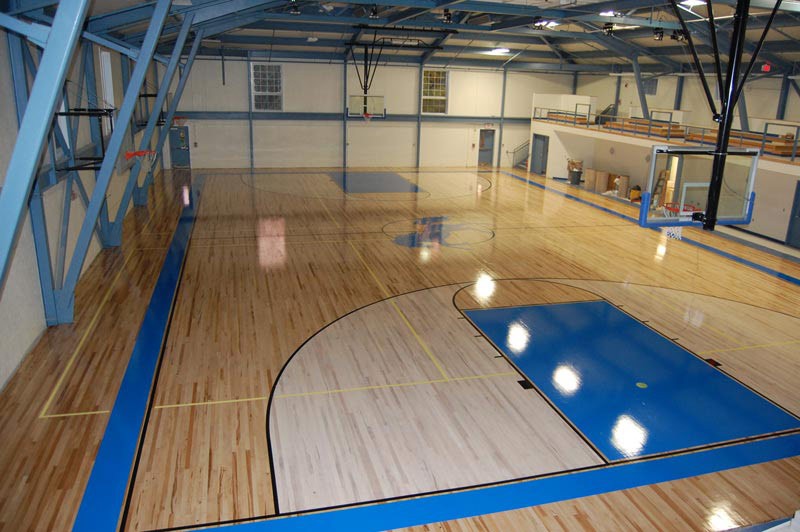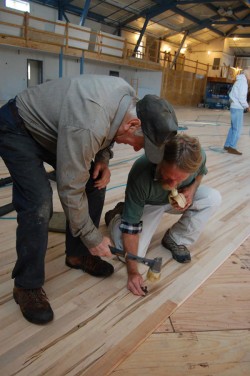This year, when Moderator Ann Wilson raps her gavel, calling the Craftsbury Town Meeting to order in the new Craftsbury Academy Gymnasium, she’ll be standing on a forest of local trees hewn into a luminous floor.
Last September, Craftsbury Academy hosted a floor-laying work party, much like an old-fashioned barn raising. Yet instead of a barn to hold one farmer’s hay and animals, they built a floor that will support the weight of this town of 1,300, serving as the foundation for jump shots, diploma handoffs, and residents trampling on their handiwork to dunk meeting day ballots into the birdseye maple ballot box.
This project was over a decade in the making, as the bond vote for the new gym failed five times. Five. Times. The Academy’s old gymnasium was officially condemned in 1986 as structurally unsound and unfit to inhabit in winds higher than 30 miles an hour. Though it was a showpiece when it was built in 1947, it had deteriorated to the point where Madame Moderator had to pause during one town meeting when a broken pipe began sputtering liquid from the ceiling. The cost of replacing the gym, however, was exorbitant, and many said it was just too much money. The issue fractured the town and dragged on for more than 12 years before a 1.6-million-dollar bond finally passed.
Harry Miller, a local builder, father, and school board member, had an idea that would bring the townspeople back together. Miller, who helps fourth graders build their own rulers as a means of teaching them fractions, thought that with a little hard work, the town could build their own gym floor for considerably less than the $150,000 that was allotted in the budget. “I thought that would be a place where we could save and participate – and we went from there,” he said.
An earlier community project to rebuild the fence around the town green provided the prototype for this one: “Have everything laid out ready to go,” Miller said, “and then call in your labor, give everybody a job. It can be done.”
Encouraged by Tom Lathrop of Lathrop’s Mill (who offered to do the millwork for one dollar per foot), informed by neighbors Jim and Steve Moffatt of Moffatt Tree Farm, and bolstered by impromptu coffee conferences in the Village Store, Miller waded into the project by asking, “How many trees do we need?”
His informal advisory committee said they’d need around 12,000 board feet. But as Jim Moffatt explained, “Of that number, you have to factor in that a portion is unusable, and then you need to account for the matching of the lumber. When you start out with a 3½-inch piece of flooring, then it’s milled down so you’re left with a 2½-inch-wide piece.” The final verdict: “Two truckloads oughta do it,” meaning, two 10-wheelers with a pup trailer.
In June 2012, Jim Moffatt, who has been a member of the Craftsbury Forestry Committee for more than 40 years, began to coordinate the harvest, skidding, and pick-up of donated trees. He mapped out the most economical route and then took his truck around town. Among the 38 scheduled pick-ups, there were several remarkable trees. Horace Strong offered the best sugar maple on his property. Bob Davis, who grew up where Bill and Judy Bevins live now, convinced them to give up their magnificent yellow birch. Miller recalled, “It was 48 feet to the first branch.”
Moffatt, who attended the Academy, as did his grandmother, mother, father, brothers, sister, wife, and son, and whose grandsons are now in the sixth and eighth grades, also offered up a special tree. “A favorite of all time,” he said, from back when he was first sugaring in 1962, with horses and buckets. “This was the tree we always tapped first, a top producer; it was slowly dying, and within a year or two the lumber wouldn’t be salvageable.”
After Moffatt rounded up the first load, he got permission from the town forest to harvest more timber. With the help of Bob Davis, Rob Libby, and his brother, Andy Moffatt, they cut 30 logs from Hatch Brook Road and the Academy Woodlot. Moffatt supplemented with his own trees, and a total of 160 sugar maple and yellow birch logs went to Lathrop’s Mill in June.
Tom Lathrop, a fifth-generation sawyer, oversaw the milling. Over the late summer months, the lumber was sawn extra thick (at 1¼ inches), stickered, and allowed to “relax” for a few months before spending ten days in the kiln. At the beginning of August, the lumber was ripped to 2¼ inches, planed to 7/8, and then sent through the tongue and groove machine. Lathrop’s favorable rate saved the town about $40,000.
Miller’s excitement at the arriving material was tempered by anxiety about humidity. “Here we were about to introduce this bone-dry flooring to an environment with 300 gallons of freshly applied paint and sheet rock mud,” Miller said. Tom Hayes of Topnotch Floors in Hardwick told him to “Call Frank.”
An affiliate of the National Wood Floor Association in Reno, Nevada, Frank Kroupa talked Miller through a strategy for the next phase. Using a humidity meter loaned by a neighbor, Miller waited for a spate of haying weather, and then opened the bags of flooring. Seven days later, when the wood had acclimated, he and his business partner, Shawn Ecklund, went in, snapped a chalkline, and that night they laid out a two-foot-wide keystone strip down the middle of the new gym.
The following morning, upwards of 60 volunteers began working on either side. A feeder crew brought boards in from the piles; the racking crew dry-laid them; an installation crew followed, tucking weed whacker cord temporarily between the slats to create a 1/16-inch expansion joint; a nail crew brought up the rear, fixing the floor piece by piece. The floor was stabilized for the next 100 years at least by $1,000 worth of nails donated by Donald Blake, a contractor in Morrisville.
By Saturday afternoon, as a small pile of rejects – strips with knots and defects – amassed near the boiler room, another crew emerged to tamp bits of tarpaper then dab quick-drying epoxy into the 363 tapholes in the flooring – a testament to the number of working sugarbushes in town. When I ask about a blond section of wood riddled with holes, Miller quizzed me. “What’s the number one rule of tapping? Never drill within three inches of last year’s taps, because the cambium around the taps dies.”
“This just goes to show that sometimes sugarmakers break their own rules,” Harry said with a smile, then added: “It may have a few imperfections, but it has character.”
By Monday, the stacks of flooring were gone and they still had a hundred feet of floor to finish. “With a custom run, you can’t run out and pick up a few more 7/8-inch pieces,” Miller said, “so, we started raiding the reject pile.” All those not-good-enough pieces were suddenly vital. Piece by piece, the rejects were reenlisted, and the floor accrued through the out-of-bound zone until the last piece fit in place. Of the two tractor loads of logs – all grown within ten miles of the gymnasium – only half a trash can of waste was left.
Miller gazed out at the finished 6,400-square-foot floor the day before the sanders came. “I watched fathers and sons, stars on the girls’ basketball team, world class skiers from the Outdoor Center’s racing team, Sterling College students – people from all over all working together to build this floor. It’s not just fitting together the pieces of a floor – it’s investment in community. These kids are going to remember this and show their kids, saying: ‘I built this.’”





